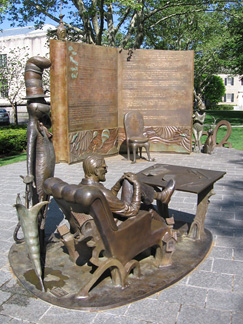industrialization & immigration
German Immigrants in Springfield
The majority of Germans immigrated to Springfield in two waves, first to escape the German Revolutions and the potato famine in the 1840's, and later to escape the Franco-Prussian War in the 1870's. Relative to many other immigrant groups, most Germans who settled in Springfield were financially well-off, better educated, and were often skilled craftsmen. Notable figures in Springfield's German community included the Gemeunders, an internationally-known family of musical-instrument-makers, Bruno Wozny, a nationally recognized architect, and Theodor Geisel, the children's book author better known as Dr. Suess.
Because of its small size, lack of geographic concentration, diversity of occupation, and willingness to learn English, Springfield's German community was largely accepted and assimilated into the broader population at an early stage. Germans kept their cultural heritage alive in a variety of ways, however — holding dances in a succession of increasingly grand German-owned hotels, and forming the Springfield Turnverein, a men's gymnastic and social club whose recitals and masquerade balls became popular social events throughout the city. During the Civil War, 75% of Springfield's Turnverein members enlisted in the Union Army.
The German community of Springfield was instrumental in the formation of a number of organizations and institutions that enlivened the arts, sports, media, and cultural life of the Connecticut River Valley.
Over the course of the nineteenth century, German-Americans organized the Springfield Schuetzenverein, a rifle club that attracted many non-German members, the Germania Lodge Mutual Benefit Society, the Trinity Evangelical Lutheran Church, and the German-language Springfielder Zeitung newspaper. During the first half of the twentieth century, German-Americans also founded the Springfield Conservatory of Music, the Hampden County Musical Association, the Springfield Orchestra, and the Connecticut Valley Horticultural Society.
Politically, German immigrants in Springfield were strongly in favor of naturalization, voted in large numbers, became enthusiastic union members, and held many positions in city government, including mayor. The German-American community's prominence and contributions to the social and cultural life of Springfield allowed it to weather anti-German propaganda and xenophobia during World War I and World War II, when even the performance of music by German composers was challenged as glorifying the enemy.
Tension between the idea of national identity and a society characterized by a variety of immigrant and ethnic groups has been a recurring theme in U.S. history. During times of perceived crisis, traditionalists and nativists in particular fear that "foreigners" pose a grave threat to national unity and "the American way of life." Even established groups with deep roots in local communities, such as the German-Americans of Springfield, have come under suspicion by others questioning their loyalty. Often forgotten are the contributions to "the American way of life" made by immigrant communities.
The political cartoons drawn by Dr. Seuss during World War II, promoting the sale of war bonds and urging support for wartime rationing, are every bit as American as the Cat in the Hat and Green Eggs and Ham.
